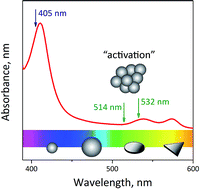A new route for SERS analysis of intact erythrocytes using polydisperse silver nanoplatelets on biocompatible scaffolds†
Abstract
Superior spectral sensitivity and functional abilities of anisotropic, instead of the usually used spherical, noble metal nanoparticles, allow development of new surface-enhanced Raman spectroscopy (SERS) approaches to analyse biological objects. We found and resolved for the first time the particular risks of survival of silver nanoparticles in different salines to succeed in recording the SERS spectra of intact erythrocytes as an important family of living cells. The ensemble of nanoplatelets with varied shapes and sizes grants multispectral absorption of laser irradiation since a fraction of the nanoparticles with a given position of a plasmonic band always exists in such a mixture, thereby providing an effective SERS amplification. At the same time, fast recrystallization of anisotropic silver nanoplatelets occurs in a standard chloride-based saline, being important to keep the erythrocytes alive but neglecting the benefits of the silver platelets as the most versatile and prospective components of SERS sensors. Substitution of chlorides with nitrates keeps both the intact cells and anisotropic nanoparticles safe on biocompatible cellulose SERS scaffolds containing the mixture of silver nanoplatelets thus promoting the development of new SERS devices for biomedical diagnostics.


 Please wait while we load your content...
Please wait while we load your content...